Eat the Rainbow
by: LIFTOFF Nutrition
The more colors on your plate, the more variety of minerals and phytonutrients (substances found in plants that are beneficial to overall health and disease prevention). And to fuel the workouts we program, you need aaallll the nutrients.
Every section of ROYGBIV has its own benefits. Here’s a more in-depth breakdown of what those are:
Red
Anthocyanins – Antioxidants that help limit cellular damage and decrease risk for stroke, cancer, heart disease and memory problems.
Lycopene – An antioxidant that may help lower risk of heart disease and cancer.
Vitamin A – Promotes eye health, tissue healing and skin health.
Vitamin C – Supports a healthy immune system.
Potassium – Important in nerve transmission, cell membrane health and cardiac function.
Folate – Essential for cellular growth and helps balance mood and energy.
Food Examples: Red cabbage, chili powder, tomatoes, cherries, raspberries, grapefruit and watermelon.
Orange & Yellow
Carotenoids (like beta-carotene and alpha-carotene) – Improves immune function and lowers risk for heart disease, cancer and vision problems.
Folate – Essential for cellular growth and helps balance mood and energy.
Potassium – Important in nerve transmission, cell membrane health and cardiac function.
Vitamin C – Supports a healthy immune system.
Food Examples: Ginger, citrus, cantaloupe, squash, sweet potatoes, carrots, peaches, mango and corn.
Green
Isothiocyanate – Supports healthy enzymatic activity in your liver and improves detoxification.
Lutein – Promotes eye health by preventing cataracts and macular degeneration.
Isoflavones – Enhances memory; may decrease the risk of cancer and can aid in combating menopausal symptoms.
Vitamin K – Helps transport calcium (so it’s essential for bone health) and is necessary for blood clotting.
Vitamin A – Promotes eye health, tissue healing and skin health.
Vitamin C – Supports a healthy immune system.
Folate – Essential for cellular growth and helps balance mood and energy.
Food Examples: Arugula, peas, broccoli, collard greens, spinach, kale, Brussels sprouts, parsley, salad greens and green and black teas.
Blue & Purple
Resveratrol – Helps decrease inflammation, especially in cardiac muscles.
Anthocyanins – Antioxidants that help limit cellular damage and reduce the risk for stroke, cancer, heart disease and memory problems.
Potassium – Important in nerve transmission, cell membrane health and cardiac function.
Folate – Essential for cellular growth and helps balance mood and energy.
Vitamin C – Supports a healthy immune system.
Food Examples: Beets, eggplant, blueberries, grapes, blackberries, purple potatoes, cocoa and red wine.
White
Allicin – Has antiviral and antibacterial properties.
Niacin (vitamin B3) – Assists in DNA repair, supports cellular signaling and controls cholesterol.
Riboflavin (vitamin B2) – Acts as an antioxidant, supports liver detoxification and iron absorption and is involved in the production of red blood cells.
Potassium – Important in nerve transmission, cell membrane health and cardiac function.
Vitamin C – Supports a healthy immune system.
Folate – Essential for cellular growth and helps balance mood and energy.
Food Examples: Garlic, parsnips, onion, coconut, apple and rutabaga.
Pro Tip: Try to incorporate at least one cup of each color daily and go for the richest colors you can (ex. a darker eggplant will have more nutrients than a lighter one)!
When it comes to overall nutrition, we preach the 80/20 rule. That means if you fill 80% of your diet with healthy, nutrient-dense foods (like the ones mentioned above), you can be more lenient with the other 20%. Life’s about balance, right?
Looking for someone to help you find the right balance for you? Sign up for LIFTOFF Nutrition coaching (personalized nutrition) and you’ll be set up with a coach to guide you through it.

